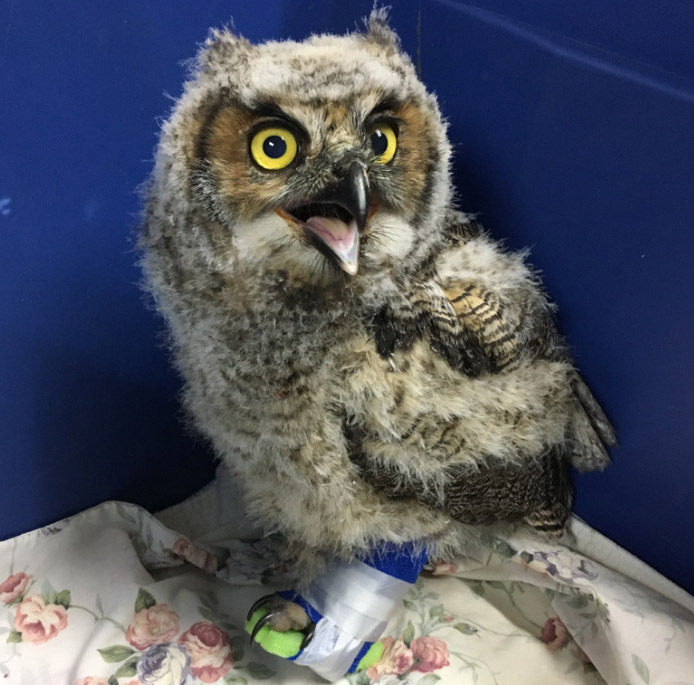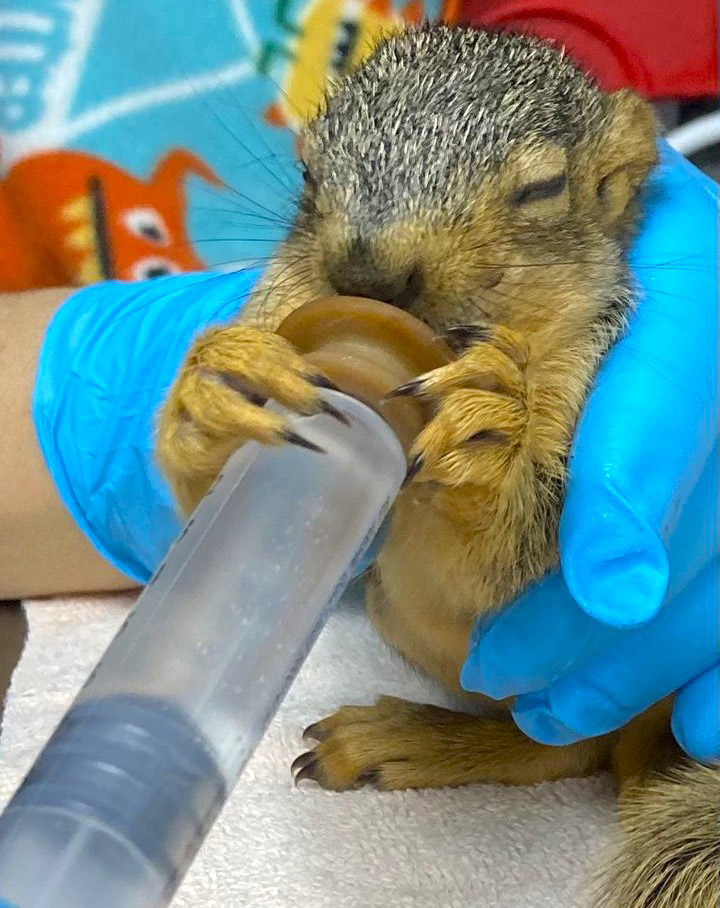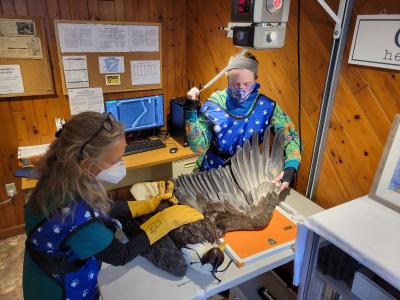Protecting Wildlife Starts in Our Own Backyards
Tamarack Wildlife Rehab Center offers tips for keeping wildlife families safe
Spring is finally here and as the weather starts to warm up, usually one of the first things we notice are the birds chirping again in the morning. Our local wildlife are beginning to raise their families during this time of year and there are several things that you can do to make sure they get off to the best start.
"One of the first things that people can do is to postpone any tree work until August through November to best protect wildlife. Some small birds and squirrels depend on tree cavities over winter," said Carol Holmgren, executive director and licensed wildlife rehabilitator at Tamarack Wildlife Rehab Center. "If a tree is felled and baby squirrels are discovered, it may still be possible to reunite the family. Mother squirrels will have several nests, so if you do find squirrels she will likely retrieve her babies." Holmgren says that you can place the babies in a box with an open lid in a warm place and wait 3-4 hours for mom to come back. If she hasn't returned by then, you can contact the center but resist the urge to feed or give water as it can cause digestive upset or pneumonia. Tamarack treated 160 squirrels last year. Holmgren explained the best outcomes were ones where the babies had not been given anything to eat or drink.
Another way we can help is to plant native plants in our yards and properties. "Native plants support native insects which provide food for our wildlife. Songbirds especially need our caterpillars to feed their young," explained Holmgren. "Baby songbirds need to be fed every 20-30 minutes for 14 hours a day. If a songbird nest has fallen, or a baby has fallen from the nest, it's not unusual to be able to reunite a family and we are always willing to coach people and help them handle a situation. Our goal is to keep wild families together," said Holmgren.
 A baby great horned owl sports a splinted left leg and is in the process of being rehabilitated at Tamarack Wildlife Center's Saegertown facility. Injured wildlife are given the best possible care at the facility, at no cost to the finder.
A baby great horned owl sports a splinted left leg and is in the process of being rehabilitated at Tamarack Wildlife Center's Saegertown facility. Injured wildlife are given the best possible care at the facility, at no cost to the finder.
"Many young fledglings will leave the nest before they are willing to fly. They are healthy, just not old enough yet to fly," Holmgren explained. She says they should be standing up and able to hop around. "Any raptors — hawks, falcons, and owl nestlings found on the ground should be brought to a wildlife rehabilitator. They can be placed in a box. If by chance you find an eagle, notifying the PA Game Commission is required, since an endangered species is involved. "Raptors fall from greater heights and have more body mass so they are more prone to injury and danger," said Holmgren. Tamarack may try to unite the raptor back with their family, try to rehabilitate the bird, or unite it with a wild foster family.
As you start your gardens this year, you may discover rabbit nests and think the baby cottontails need help because you don't see any adult rabbits around. "Mothers are away during the day and return at dawn and dusk for feeding," said Holmgren. "She has a lot of scent, so she stays away to protect them." If you do disturb a nest, cover the area back up. Holmgren suggests placing a string or sticks in a tic-tac-toe shape to be able to check later and see if the mother has been back. To protect a nest of rabbits from the family dog, Holmgren suggests either keeping the dog leashed or on a line for a couple of weeks while the babies grow up, or covering the nest with a laundry basket during the day to protect them, removing it in the evening.
Most cottontails are completely independent in 15-21 days. There is usually something wrong if you can approach adult wildlife but young cottontails can sometimes be easily approached. This does not mean you should or that they need our help. Cats outdoors can also pose a danger to songbirds and baby cottontails. Holmgren suggests leashing them or keeping them inside. Any animal caught by a cat needs treatment and antibiotics. Cottontails are seen quite frequently at Tamarack — about 350 were treated last year. Highly skilled volunteers are required to feed and monitor the babies in a very quiet, dark, low stress environment.
When you are out on the roads this spring, try to avoid hitting turtles if you see them crossing the road. If it is safe to do so, you can help them cross. Turtles always have a destination in mind and you should always move them in the direction in which they are traveling. Tamarack does some shell repair if you find a turtle in the wild who has an injured shell, but it is important to remember exactly where the turtle was found so that it can be returned to its habitat once healthy.
Another frequent visitor to Tamarack is the Virginia opossum. They have become quite popular wildlife because they typically don't carry rabies, are North America's only marsupial, are omnivores, and they are nature's clean-up crew, so they eat most everything that humans consider a nuisance. Opossums are also immune to snake venom. Sometimes an infant opossum is seen if the mother gets hit by a car since the babies travel on their mother or in her pouch. "If you find a baby opossum that is less than seven inches long from nose to butt, not including the tail and it is not with the mother, it needs help," said Holmgren. She said they treated about 200 opossums last year.
Tamarack offers a Wildlife First Responders Course online each February that teaches when to intervene and when not to, as well as how to capture, stabilize, and transport injured wildlife to a rehabilitator. In addition to learning how to respond when encountering wildlife in need, participants develop some of the skills necessary to become Tamarack volunteers. The course can be used towards state licensure and as a capture/transport permittee, as well. You can find more information about the course on their website.
 If you find injured wildlife or abandoned baby animals or birds, give them their best chance of survival by not giving them food or water, and keeping them in a dark, secure box with small air holes until you can get them to the rehabilitation center.
If you find injured wildlife or abandoned baby animals or birds, give them their best chance of survival by not giving them food or water, and keeping them in a dark, secure box with small air holes until you can get them to the rehabilitation center.
Injured wildlife has a higher chance of surviving if you do the following: no food or water, keep the wildlife in a safe, dark, quiet and warm place such as a cardboard box with small air holes and paper towels on the bottom (avoid peeking to help reduce their stress levels).
Wildlife with injuries are now receiving improved care when they arrive at Tamarack due to a recently acquired on-site digital x-ray machine. The Erie Community Foundation, Crawford Heritage Community Foundation, Kenneth A. Scott Charitable Trust, a KeyBank Trust, and other supporters have provided the funds necessary for wildlife patients to be able to be diagnosed in just minutes with this technology. The images can then be emailed to supporting veterinarians or other experts for interpretation. Previously patients had to be taken to area veterinary clinics for x-rays. This meant that only a very small fraction of Tamarack's many patients could get x-rays due to the expense, staff time, and stress on the animal during transport to a veterinary clinic.
"We are always looking to improve and Tamarack's x-ray equipment is already improving patient care," said Holmgren. "Since no extra expense is incurred when we take additional images, we have been able to x-ray patients that may not have received one in the past. A Cooper's hawk from Erie admitted in December was unable to fly but had no fractures that could be felt in a physical exam. The x-ray revealed a fractured bone in his shoulder girdle, which responded well to treatment once diagnosed," she said. That bird was released back to its Erie home in late January.
For a red-tailed hawk with a wing fracture, follow-up x-rays taken mid-treatment showed that bone healing was proceeding more slowly than was typical, so his time in a splint was extended. For an eagle with a swollen foot and wound, the diagnostic x-ray confirmed there was no bone infection involved with the injury, so the patient had a promising prognosis and was able to receive less aggressive treatment, and no oral antibiotics or surgery were needed.
Erie is home to many types of birds and wildlife with the Lake Erie shoreline being a vital path for migrating birds this time of year. Tamarack has partnered with the Erie Bird Observatory in monitoring migratory birds who are often thrown off by reflective glass on buildings downtown or by interior and exterior city lights, which can disorient the birds. This new project called BirdSafe Erie is recruiting volunteers to walk specific morning routes April through May looking for injured or dead birds. You can find more information about this program at eriebirdobservatory.org/birdsafe-erie.
Spring is the perfect time to familiarize yourself with all of the wildlife living in your neighborhood. "Get outside and enjoy the wildlife. Our area is full of migratory birds, screech owls, great horned owls, red-tailed hawks, and peregrine falcons," said Holmgren.
Tamarack Wildlife Center offers professional, licensed wildlife rehabilitation at no cost to the finder. TWC is a 501(c)3 not for profit organization supported by individual and corporate donors and does not receive state or federal funding. You can find more information on their website tamarackwildlife.org. Tamarack is also on Facebook and Instagram @tamarackwildlife.
Amy VanScoter is a local yoga teacher and communications professional who can often be found outdoors enjoying wildlife and staring at the sky looking for hawks. She can be reached at avanscoter@gmail.com




